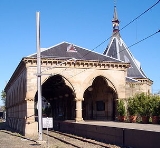
Regents Street railway station, Sydney
Encyclopedia


Sydney
Sydney is the most populous city in Australia and the state capital of New South Wales. Sydney is located on Australia's south-east coast of the Tasman Sea. As of June 2010, the greater metropolitan area had an approximate population of 4.6 million people...
's Rookwood Cemetery railway line. Funeral trains departed from the station, being bound for Rookwood Cemetery
Rookwood Cemetery
Rookwood Cemetery is the largest multicultural necropolis in the Southern Hemisphere, located in Sydney, New South Wales, Australia...
. The station found later use as a part of Sydney Yard. The ornate station building is still standing on the western side of Sydney Yard, close to Central railway station
Central railway station, Sydney
Central Railway Station, the largest railway station in Australia, is at the southern end of the Sydney CBD. It services almost all the lines on the CityRail network, and is the major terminus for interurban and interstate rail services...
and Railway Square
Railway Square, Sydney
The area is not a true square but is a confluence of Broadway, Lee Street, Pitt Street and George Street. The University of Technology, Central railway station and the now closed Kent Brewery are adjacent to Railway Square.-History:...
.
History
The station opened as Mortuary on 29 June 1869. At some point, its name was changed to Regent Street, after the street on which it is located. It has also been referred to by different names, including the Necropolis Receiving Station and the Mortuary Station.. The station was built as part of the larger Rookwood Cemetery line. It was completed on the 22nd March 1869 but had been used since the 1st January 1869. It was also one end of the service that ran to the Woronora General Cemetery in Sutherland, located south of Sydney, and for trains heading to Sandgate Cemetery in Newcastle.This and the Receiving House station at Rookwood Cemetery
Rookwood Cemetery
Rookwood Cemetery is the largest multicultural necropolis in the Southern Hemisphere, located in Sydney, New South Wales, Australia...
were designed by colonial architect James Barnet
James Barnet
James Johnstone Barnet was the Colonial Architect for New South Wales from 1862 - 1890.-Life and career:Barnet was born at Almericlose, Arbroath, Scotland. The son of a builder, he was educated at the local high school...
using elements from the Venetian 13th century Gothic
Gothic architecture
Gothic architecture is a style of architecture that flourished during the high and late medieval period. It evolved from Romanesque architecture and was succeeded by Renaissance architecture....
style. Principal sculptors Thomas Ducket and Henry Apperly worked on the elaborate carvings that were a feature of the stations, including angels, cherubs, and gargoyles. Although both buildings were designed to look like churches, both in structure and in the symbolic elements that adorned them, they were never used as places of worship
Worship
Worship is an act of religious devotion usually directed towards a deity. The word is derived from the Old English worthscipe, meaning worthiness or worth-ship — to give, at its simplest, worth to something, for example, Christian worship.Evelyn Underhill defines worship thus: "The absolute...
.
From 14 March 1938, the station found a new use as a platform for horses and dogs. From February 1950, it was used as a platform for parcels.. It was restored by the State Rail Authority in 1981. By this time it had also been classified by the National Trust of Australia
National Trust of Australia
The Australian Council of National Trusts is the peak body for community-based, non-government organisations committed to promoting and conserving Australia's indigenous, natural and historic heritage....
and the Australian Heritage Commission and made part of Permanent Conservation by the Heritage Council of NSW. The cost of restoring the site was approximately $600,000. It was reopened on the 21st of April 1985 by Neville Wran
Neville Wran
Neville Kenneth Wran, AC, CNZM, QC was the Premier of New South Wales from 1976 until 1986. He was National President of the Australian Labor Party from 1980 to 1986 and Chairman of both the Lionel Murphy Foundation and the Commonwealth Scientific and Industrial Research Organisation from 1986...
.
From 1986 to 1989, a pancake restaurant, the 'Magic Mortuary' operated there, using railway carriages to house the diners. Subsequently, the station has occasionally been used as a venue to launch special train services and informative displays, and as a hired function centre.

